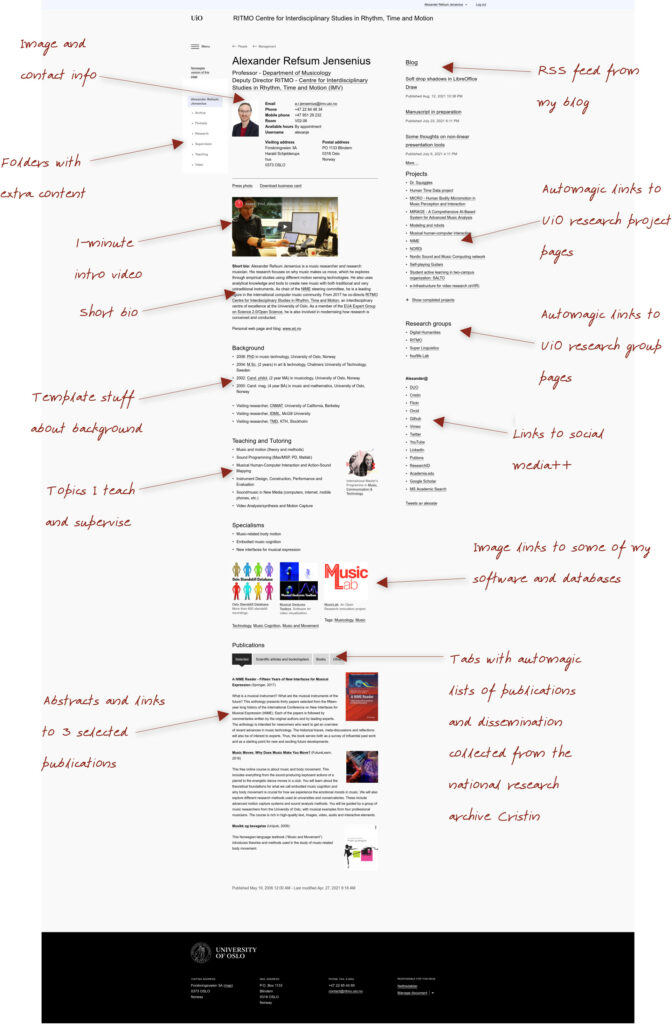Earlier this year, I wrote about my 23 tips to improve your web presence. Those tips were meant to encourage academics to care about how their employee web pages look at universities. Such pages look different from university to university. Still, in most places, they contain an image and some standard information on the top, followed by more or less structured information further down. For reference, this is an explanation of how my employee page is built up:

Arguments for why universities should care
Academics need to be visible online. If you don’t publish and disseminate your research, it won’t have an impact. So it is in our own interest to have up-to-date personal pages with information about what we do. I would argue that it is also in the interest of universities that their employee’s personal pages are up-to-date and look good. My argument goes like this:
- The people are the most important asset of a university
- The web is the most important dissemination channel
- Hence the employee pages should be the most important part of a university web page
For some reason, this appears to be a radical statement. In my experience, many universities think of the employee pages as a “phonebook.” It is a static page with minimal information about how to get in touch with the employee. There is often a template for the page, including information about educational background. Sometimes there is also information about courses taught and research output. But rarely does it contain much more stuff. There also seems to be little institutional interest in maintaining and improving such web pages.
The employee page is an important research infrastructure
Last year, I wrote in the UiO newspaper about considering the university’s web pages as a research infrastructure. In my experience, the web pages of a university are maintained by a communication department. They have one opinion on the purpose of the web pages: communication with students and the general public. I agree that these are the largest user groups of our web pages. But, in addition, we need to remember that researchers also communicate with other researchers.
Research communication is not the same as researcher communication. The former is dissemination activities targeting the broad public. The latter is based on ongoing intellectual exchange with research colleagues around the world. In my experience, communication departments care mostly about the first category. It is typically the role of university libraries to care about the other. Unfortunately, not many librarians are involved in the making and structuring of web pages. In my opinion, they should be.
Web pages as part of the transition to Open Research
I have previously written about why Open Research is better research and why I prefer Open Research over Open Science. In this context, I would mention that I believe university web pages, particularly employee web pages, are key to making a full transition to Open Research. Yes, we should focus on making publications Open Access and datasets FAIR. That should happen through proper repositories with unique IDs, and so on. However, the ambition of moving towards Science 2.0 goes beyond only opening the research results. We also need to open the various parts of the research process. Then I am thinking about the various building blocks of Open Research, as sketched in this figure:

The various parts in this ecosystem will live in different repositories and be scattered around the web. In my thinking, a person’s employee page is the place to gather all this information. It can serve as the hub of an academic’s activities.
Empowering the academics
It is in the interest of universities to provide their employees with the tools needed to store, share, and link to their research material. Many universities don’t seem to care too much about this. The result is that many employees don’t care either. Those who care will make their own solutions. Many set up private web pages with their own domains. Others use one of the social media sites for academics. These sites have understood how to make it fun to add information. It is a pity that universities don’t do the same.
At UiO, we are fortunate to have the possibility to edit the content of our personal pages. There are still things that could improve our system, and I regularly nag both the IT and communication departments about those issues. Still, I am fortunate to work at a university that empowers its academics with the possibility to update their own information. That is not the case in all universities. Some universities don’t allow employees to modify anything at all. I think that is a bad idea. It is bad for the employees, the university, and the transition to Open Research.
To all university leaders out there: how do you work with your university’s employee pages? To all academics: remember to update your personal page! And if you are not allowed to, ask your leaders to give you the tools and access to do so.